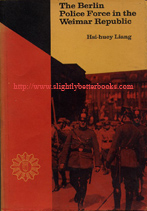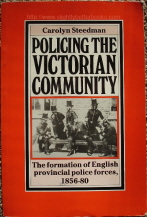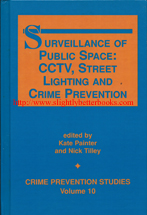
1970, University of California, hbk
In stock, click to buy for £21.00, not including p&p
Alternative online retailers to try:
Click here to access our prebuilt search for this title on Abebooks
Or click here to access our prebuilt search for this title on Alibris
Or click here to access our prebuilt search for this title on Ebay



|
- The Berlin Police Force in the Weimar Republic [top]
Written by Hsi-huey Liang
First published in 1970 in the United States by the University of California Press, in hardback with dustjacket, 252pp, ISBN 0520016033 . Cover design by James Mennick. Dedicated to the author's father, the late Dr. Lone Liang, Chinese Chargé d'Affaires in Berlin, 1928-1934 . Cover design by James Mennick. Dedicated to the author's father, the late Dr. Lone Liang, Chinese Chargé d'Affaires in Berlin, 1928-1934
About this book/synopsis: Police work is made extra difficult and complicated when it is performed in a backdrop of political unrest and revolution, social flux, inflation and unemployment - especially if the police force is simultaneously called on to remake itself in a democratic image. The performance of the Berlin police during the time of the Weimar Republic shows exactly what the general state of affairs was in Germany's capital during the 1920s.
More important still, an examination of police records can show to what extent the Prussian police reforms, often praised as belonging to the best achievements of Social Democracy in the Weimar Republic, did provide an effective protection for the first German Republic.
Based on local histories, newspapers, police documents, court records and personal interviews with veterans of the Berlin police, and contemporary novels, this book looks closely at the political loyalties of the rank and file policeman during the bitter fighting between the Communists and the Nazis over control of the streets of Berlin. The author concludes that the hidden sympathies for the Hitler movement among a minority of the police was not in itself fatal to the Republic. More harmful was the naive faith, held by many public servants, that political responsibilities were best left to politicians
Chapters:
Preface
Abbreviations not Explained in the Text
Introduction
1. The Historical Legacy of the Schutzpolizei
The Importance of Traditional Police Doctrine
The Official Interpretation of Prussian Police History
2. The Background of Fear and Irresolution, 1918-1920
The War and the Armistice
The Eichhorn Episode
Rivalry with Military Forces
3. The Berlin Schutzpolizei, 1920-1932
Organization, Physical Training, Equipment
Social Background, Material Compensation, Police Unions, Discipline
Political Education
Subversion and Security Checks in the Schutzpolizei
The Schutzpolizei in Action: 1920-1932
4. The Detective Force
Public opinion on Crime and the Criminal Police
The Kriminalpolizei in Search of Professional Autonomy
Success and Integrity in the Kriminal Polizei
5. The End of a Police Era
From the Papen Putsch to Hitler's Seizure of Power
The Purge, 1933
Epilogue
Appendix: Interviews; Notes; Bibliography; Index
List of Illustrations
i. Before the First World War, military parades dominated the street picture
ii. Constables of the royal Schutzmannschaft
iii. Members of the short-lived Sipo
iv. Police Presidium at Alexanderplatz
v. A Sipo Patrol
vi. Schupo Commander Magnus Heimannsberg
vii. The Kapp Putsch
viii. Armoured car during Kapp Putsch
ix. Schupo Commander Hugo Kaupisch
x. Police officials Gotze, Weiss, Heimannsberg, Zorgebiel, and Haupt
xi. Dr. Weiss and Commander Heimannsberg with police athletes
xii. Minister of Interior Carl Severing
xiii. Depute Police President Dr. Bernhard Weiss
xiv. Ernst Gennat
xv. The Schlosskaserne
xvi. Mounted police guarding the Reichstag, 1930
xvii. Police restraining crowds on Hindenburg's birthday
xviii. Police escorting Communist May Day Parade
xix. Police escorting Nazi parade
xx. Communist insurgents
xxi. Police attacking Communists
xxii. Schupos intercepting Communist agitation team
xxiii. Armoured police car
xxiv. Police protecting S.A. demonstration
xxv. Main Communist headquarters
xxvi. Funeral of Horst Wessel
xxvii. Monument to Police Captains Anlauf and Lenck
Maps
1. Berlin Administrative Districts
2. The Police Problem in the central districts of Berlin |
Other books on the Weimar Republic:
History of Policing
|

1984, Routledge & Kegan Paul, pbk
Sorry, sold out, but click image to access prebuilt search for this title on Amazon
Alternative online retailers to try:
Click here to access our prebuilt search for this title on Abebooks
Or click here to access our prebuilt search for this title on Alibris
Or click here to access our prebuilt search for this title on Ebay



|
About the book/synopsis: The year 1856 saw the first compulsory Police Act in England (and Wales). Over the next thirty years, a class society came to be policed by a largely working-class police. This book traces the process by which men made themselves into policemen, translating ideas about work and servitude, about local government and local community, into sets of personal beliefs. Among the issues dealt with are the division of labour in police hierarchies, the emergence of Victorian policing as both a craft and a profession, and the way in which notions of professionalism were used by certain policemen to argue against what would in modern terms, be called accountability. The author describes how provinical watch committees and rural magistracies developed during the period from 1856-1880, and shows how their understanding of social discipline and community order provided the background to the development of mid-nineteenth-century police forces.
By tracing the evolution of a policed society through the agency of local police forces, the book illustrates the ways in which a society, at many levels and from many perspectives, understood itself to operate, and the ways in which theories of ownership, servitude, obligation, and the reciprocality of social relations manifested themselves in different communities.
Important Note: For anyone researching the police, this book is invaluable. The notes section covering each chapter, which sits at the back of the book lists hundreds of publications: law reviews, newspapers, books, theses & journals, will either help you extend your research or kick it off to a really good start.
This is not to forget the bibliography & sources section that lists generally materials available at the Public Record Office, County Record Offices, Borough Record Offices, Private Papers and Newspapers, Miscellaneous printed materials, Directories, Parliamentary papers, Books and Articles.
Chapters:
Preface; Acknowledgements; Abbreviations; Introduction
Part One. Government and Policing
i. Legislation
ii. Towards 1856: models and theories
iii. Towards 1856: soldiers and policemen
iv. The County and Borough Police Act
v. The Home Office and the provinces
vi. Policemen as soldiers: the Murphy Riots
vii. The Government Inspectors of Constabulary
viii. Borough versus county
ix. The pattern of county policing
x. The structure of county control
xi. The rise and fall of an administrative police
xii. The police and the vagrant poor
xiii. Ratepaying as theory
Part Two. Men and Policemen
2. Making a County Force
3. Origins
4. Becoming Policeman
5. A Policeman's Life
6. An entirely new situation
7. Security: the campaign for police pension rights
8. Identity
i. Policemen as working men: on strike
ii. The trade of policeman
iii. Good and faithful servants
9. Possibilities: the example of the licencing laws
10. Conclusion
Notes
Bibliography
Index
About the Author:
Carolyn Steedman at the time of publication had studied history at the University of Sussex; also at Newnham College, Cambridge. She was working on a language project at the University of London Institute of Education in 1984 |
�
Other books of potential interest on policing in the UK:
|

1998, Ashgate Publishing, hbk
Alternative online retailers to try:
Click here to access our prebuilt search for this title on Abebooks
Click here to access our prebuilt search for this title on Alibris
Click here to access our prebuilt search for this title on Ebay to access our prebuilt search for this title on Ebay
Click here to access our prebuilt search for this title on Biblio

 |
Contents:
List of contributors; Acknowledgements
PART ONE:
Introduction
1. Introduction: Power and Vision by Clive Norris & Gary Armstrong
PART TWO: CCTV and Social Theory:
2. Closed Circuit Television and the City by Jon Bannister, Nicholas R. Fyfe & Ade Kearns
3. Beyond Foucault: Towards a Contemporary Theory of Surveillance by Michael McCahill.
PART THREE: CCTV In Context:
4. The Panopticisation of Shopping: CCTV and Leisure Consumption by Alan Reere
5. Towards the Fifth Utility? On the Extension and Normalisation of Public CCTV by Stephen Graham
6. From Another Angle: Police Surveillance and Football Supporters by Gary Armstrong & Richard Giulianotti.
PART FOUR: Evaluating CCTV:
7. Evaluating the Effectiveness of CCTV Schemes by Nick Tilley
8. Evaluating Scotland's First Town Centre CCTV Scheme by Jason Ditton & Emma Short
9. Crime Reduction, Diffusion and Displacement: Evaluating the Effectiveness of CCTV by David Skinns
10. CCTV and Shop Theft: Towards a Realistic Evaluation by Martin Gill & Vicky Turbin
PART FIVE: Questioning CCTV:
11. What's the problem, girls? CCTV and the Gendering of Public Safety by Sheila Brown
12. Public Support for Town Centre CCTV Schemes - myth or reality? By Jason Ditton
13. Restraining Big Brother? The Regulation of Surveillance in England and Wales by Mike Maguire
PART SIX: CCTV: The Future and the Past
14. CCTV: A New Battleground for Privacy by Simon G. Davies
15. Algorithmic Surveillance: The Future of Automated Visual Surveillance by Clive Norris, Jade Moran and Gary Armstrong
16. A Brief Chronology of Photographic and Video Surveillance by J.Moran |
Other surveillance books
|

1999, Criminal Justice Press, hbk
Alternative online retailers to try:
Click here to access our prebuilt search for this title on Abebooks
Click here to access our prebuilt search for this title on Alibris
Click here to access our prebuilt search for this title on Ebay to access our prebuilt search for this title on Ebay
Click here to access our prebuilt search for this title on Biblio |
Contents:
Editors' Introduction: Seeing and Being to Prevent Crime by Kate Painter and Nick Tilley
1. Privatopia on Trial? Property Guardianship in the Suburbs by Tim Hope
2. A Review of Street Lighting Evaluations: Crime Reduction Effects by Ken Pease
3. Street Lighting and Crime: Diffusion of Benefits in the Stoke-on-Trent Project by Kate Painter and David P. Farrington
4. A Review of CCTV Evaluations: Crime Reduction Effects and Attitudes Towards Its Use by Coretta Philips
5. CCTV and the Social Structuring of Surveillance by Clive Norris and Gary Armstrong
6. Evaluating "Realistic Evaluation": Evidence from a Study of CCTV by Martin Gill and Vicky Turbin
7. Yes, It Works, No, It Doesn't: Comparing the Effects of Open-Street CCTV in Two Adjacent Scottish Town Centres by Jason Ditton and Emma Short
8. Burnley CCTV Evaluation by Rachel Armitage, Graham Smyth and Ken Pease
9. Context-Specific Measures of CCTV Effectiveness in the Retail Sector by Adrian Beck and Andrew Willis |
|







